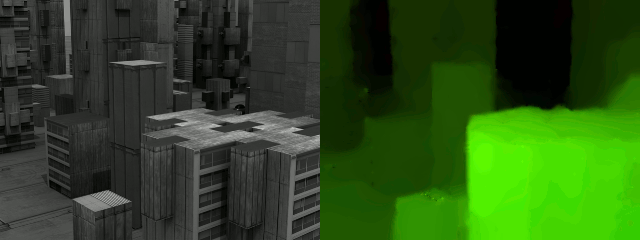Example Dense Optical Flow
From BoofCV
Jump to navigationJump to searchDense optical flow compares two images to estimate the apparent motion of each pixel in the one of the images. It is used in video compression, object detection, object tracking, and image segmentation. Dense optical flow is a computationally expensive operation and many techniques use hardware acceleration.
Example Code:
Concepts:
- Optical Flow
Example Code
/**
* Demonstration of how to compute the dense optical flow between two images. Dense optical flow of an image
* describes how each pixel moves from one image to the next. The results is visualized in a color image. The
* color indicates the direction of motion and the intensity the magnitude.
*
* @author Peter Abeles
*/
public class ExampleDenseOpticalFlow {
public static void main( String[] args ) {
MediaManager media = DefaultMediaManager.INSTANCE;
// String fileName0 = UtilIO.pathExample("denseflow/dogdance07.png");
// String fileName1 = UtilIO.pathExample("denseflow/dogdance08.png");
String fileName0 = UtilIO.pathExample("denseflow/Urban2_07.png");
String fileName1 = UtilIO.pathExample("denseflow/Urban2_08.png");
// String fileName0 = UtilIO.pathExample("denseflow/Grove2_07.png");
// String fileName1 = UtilIO.pathExample("denseflow/Grove2_09.png");
DenseOpticalFlow<GrayF32> denseFlow =
// FactoryDenseOpticalFlow.flowKlt(null, 6, GrayF32.class, null);
// FactoryDenseOpticalFlow.region(null,GrayF32.class);
// FactoryDenseOpticalFlow.hornSchunck(20, 1000, GrayF32.class);
// FactoryDenseOpticalFlow.hornSchunckPyramid(null,GrayF32.class);
FactoryDenseOpticalFlow.broxWarping(null, GrayF32.class);
BufferedImage buff0 = media.openImage(fileName0);
BufferedImage buff1 = media.openImage(fileName1);
GrayF32 full = new GrayF32(buff0.getWidth(), buff0.getHeight());
// Dense optical flow is very computationally expensive. Just process the image at 1/2 resolution
GrayF32 previous = new GrayF32(full.width/2, full.height/2);
GrayF32 current = previous.createSameShape();
ImageFlow flow = new ImageFlow(previous.width, previous.height);
ConvertBufferedImage.convertFrom(buff0, full);
new FDistort(full, previous).scaleExt().apply();
ConvertBufferedImage.convertFrom(buff1, full);
new FDistort(full, current).scaleExt().apply();
// compute dense motion
denseFlow.process(previous, current, flow);
// Visualize the results
PanelGridPanel gui = new PanelGridPanel(1, 2);
BufferedImage converted0 = new BufferedImage(current.width, current.height, BufferedImage.TYPE_INT_RGB);
BufferedImage converted1 = new BufferedImage(current.width, current.height, BufferedImage.TYPE_INT_RGB);
BufferedImage visualized = new BufferedImage(current.width, current.height, BufferedImage.TYPE_INT_RGB);
ConvertBufferedImage.convertTo(previous, converted0, true);
ConvertBufferedImage.convertTo(current, converted1, true);
VisualizeOpticalFlow.colorized(flow, 10, visualized);
AnimatePanel animate = new AnimatePanel(150, converted0, converted1);
gui.add(animate);
gui.add(visualized);
animate.start();
ShowImages.showWindow(gui, "Dense Optical Flow", true);
}
}
